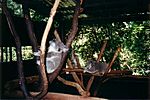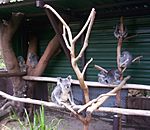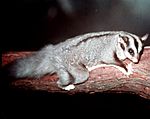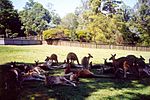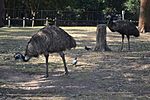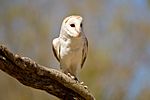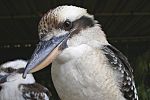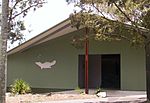Lone Pine Koala Sanctuary facts for kids
 |
|
| Date opened | 1927 |
|---|---|
| Location | Fig Tree Pocket, Queensland, Australia |
| Land area | 18 ha (44 acres) |
| Coordinates | 27°31′58.56″S 152°58′9.47″E / 27.5329333°S 152.9692972°E |
Lone Pine Koala Sanctuary is a special place in Brisbane, Australia, where koalas and other Australian animals are protected. It covers about 18 hectares (that's like 44 football fields!). This sanctuary started way back in 1927, making it the oldest and biggest koala sanctuary in the whole world. You can find around 80 different kinds of Australian animals living here.
Contents
History of Lone Pine Koala Sanctuary
The name "Lone Pine" comes from a single hoop pine tree. This tree was planted by the Clarkson family, who first owned the land. The sanctuary opened its doors in 1927. Its main goal was to give a safe home to koalas that were sick, hurt, or had lost their parents. At that time, many koalas were being hunted for their fur. The sanctuary's founder, Claude Reid, knew these amazing animals needed protection. He worked hard to save their homes too.
The sanctuary began with just two koalas named Jack and Jill. Lone Pine became famous around the world during World War II. Many American visitors, including the wife of General Douglas MacArthur, came to see Australia's unique animals.
Amazing Australian Wildlife
Lone Pine Koala Sanctuary is home to many incredible animals. Visitors can get up close to some of them.
Koalas and Their Care
Until the end of June 2024, visitors could hold some koalas for a small fee. There were very strict rules to keep the koalas safe and happy. For example, each koala was held for no more than 30 minutes a day. Only koalas born in the sanctuary with a calm nature were chosen. The money from these photos helped pay for new homes for the animals. It also supported research and growing eucalyptus trees for koala food.
Since July 1, 2024, visitors are no longer allowed to hold koalas. However, you can still get very close to them and take photos. Some animal welfare groups had concerns about holding koalas. But interesting research from Griffith University showed something surprising. Koalas used to being held actually showed signs of stress during the COVID pandemic lockdowns. This happened when people couldn't visit the sanctuary.
Kangaroos and Other Animals
You can walk into a large area where kangaroos roam freely. This kangaroo reserve is about 5 hectares big. You can even feed and gently pet the kangaroos there.
Rainbow lorikeets are colorful birds that fly to the sanctuary. They come for special nectar meals prepared just for them. Visitors can also help feed these noisy, beautiful birds. Once a day, there is an exciting bird of prey show. You can watch different kinds of raptors, like eagles and falcons. They show off their amazing speed, agility, and sharp eyesight.
The "Koala Forest" is a very big area where over 30 koalas live. It's designed so visitors can walk right among them. The koalas are fed in the middle of the morning and again in the middle of the afternoon.
Koala Science and Research
Lone Pine Koala Sanctuary opened a new science and research center on June 30, 2018. It's called the Brisbane Koala Science Institute. This center was built with help from the Brisbane City Council. It has two full-time researchers and a special lab. There's also a "Koala Biobank," which stores koala genetic information. Lone Pine hopes this institute will help scientists work together more. Visitors can watch the research happening from a public viewing area every day.
Mammals
- Koala
- Common wombat
- Southern hairy-nosed wombat
- Platypus
- Short-beaked echidna
- Red kangaroo
- Eastern grey kangaroo
- Lumholtz's tree-kangaroo
- Red-necked wallaby
- Swamp wallaby
- Tasmanian devil
- Dingo
- Grey-headed flying fox
- Spectacled flying fox
- Little red flying fox
- Northern brown bandicoot
- Australian miniature goat
- Guinea pig
- Miniature pig
- Sheep
Birds
- Emu
- Southern cassowary
- Wedge-tailed eagle
- Peregrine falcon
- Black kite
- Brahminy kite
- Eastern barn owl
- Barking owl
- Tawny frogmouth
- Laughing kookaburra
- Red-tailed black cockatoo
- Major Mitchell's cockatoo
- Gang-gang cockatoo
- Sulphur-crested cockatoo
- Princess parrot
- Rainbow lorikeet
- Bush stone-curlew
- ISA brown chicken
Reptiles and amphibians
- Freshwater crocodile
- Saltwater crocodile
- Lace monitor
- Mertens' water monitor
- Spiny-tailed monitor
- Pygmy mulga monitor
- Central bearded dragon
- Rankin's dragon
- Eastern blue-tongued lizard
- Shingleback lizard
- Hosmer's spiny-tailed skink
- Pond slider
- Black-headed python
- Carpet python
- Olive python
- Woma python
- Centralian carpet python
- Common death adder
- Broad-headed snake
- Magnificent tree frog
Getting to the Sanctuary
You can reach Lone Pine Koala Sanctuary in a few different ways. There's an entrance from a car park if you drive or take a taxi. The drive from the city center takes about 20 minutes. You can also arrive by bus from Transport for Brisbane. Another fun way to get there is by express boat. This boat leaves from the Queensland Cultural Centre pontoon on the Brisbane River.
Photos
Awards and Recognition
In 2009, Lone Pine Koala Sanctuary received a special honor. As part of the Q150 celebrations, it was named one of the "Q150 Icons" of Queensland. This award recognized its important role as a famous location in the state.
See also
 In Spanish: Lone Pine Koala Sanctuary para niños
In Spanish: Lone Pine Koala Sanctuary para niños
- Australian Koala Foundation
- Marsupial
- Koala Park Sanctuary, Sydney
- Koala Farm, Adelaide
- Koala conservation § Introductions


